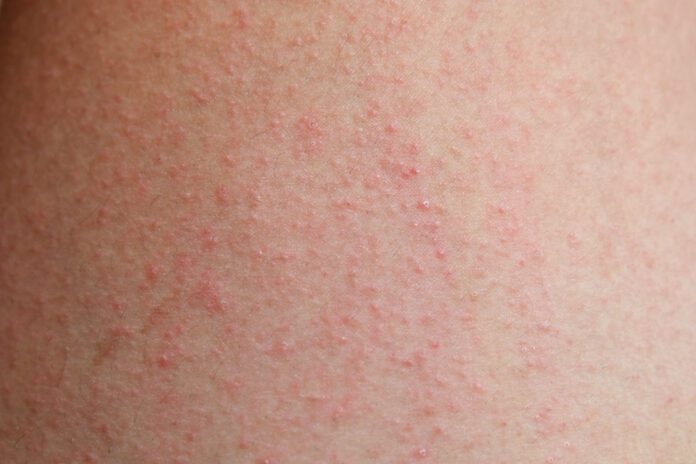Overview
Grover’s disease is a skin condition that causes the appearance of small, red spots. These spots usually develop on the chest or back, but may also form on other parts of the body. This condition frequently leads to intense itching, although it may cause no symptoms. Most cases last six to twelve months. Occasionally, this condition may persist for longer periods, or it may come and go over time.[1] The exact cause is unknown; however, a number of factors may cause or worsen the condition including heat and sweating. While there is no cure for Grover’s disease, there may be ways to manage the condition, such as avoidance of factors that worsen symptoms, moisturizers, and topical corticosteroids
Cause
The cause of Grover’s disease is not well understood.
There are certain factors that are suspected to lead to the development of Grover’s disease or worsen symptoms including:
• Heat and sweating
• Sunlight
• Exposure to ionizing radiation (example sun, microwaves, X-rays)
• End-stage renal disease (kidney failure)
• Prolonged bed rest
Some cases of Grover’s disease have been associated with certain medications, including antiviral medications, such as ribavirin, and biologic agents used for cancer therapy, such as anastrozole. Grover’s disease has additionally been found in individuals who have other similar dermatological diseases, such as atopic dermatitis and contact dermatitis.
Symptoms
Symptoms of Grover’s disease are small, solid, raised bumps on the skin; separation of connective tissue in the skin’s outer layers (acantholysis); and itching (pruritus). For some patients, the itching may be severe. Patients with this disorder often have blisters containing a thin, watery liquid with hair follicles (recessed spots with a central hair) within the affected area. The skin eruptions are found in groups and have a swollen, red border around them. The formation of skin overgrowth (hyperkeratosis) occurs above the blisters. There is an abnormality of the horny layer of the skin resulting from a disturbance in the process by which skin cells, damaged by the environment, attach to each other.
The eruptions in Grover’s disease are usually found on the back, chest, and sometimes on the sides of the extremities (arms and legs) and can last from a few weeks to many months. The disease usually recedes at its own pace (self-limiting).
Treatment
There is no cure for Grover’s disease and treatment is usually based on a person’s symptoms. Affected individuals are usually advised to avoid strenuous exercise and excessive sun exposure, as sweating and heat may induce more itchy spots. Initial treatment options include topical steroid creams such as hydrocortisone, anti-itch lotions containing menthol or camphor, and calcipotriol cream. For more severe cases, options include tetracycline, isotretinoin, antifungal pills such as itraconazole, PUVA phototherapy, and cortisone (steroid) injections. These treatments have important side effects and may not be necessary for mild cases.
Other
Symptoms of the following disorders can be similar to those of Grover’s disease.
Comparisons may be useful for a differential diagnosis:
Darier disease is a gradually progressive, hereditary skin disorder. It is characterized by elevated spots (papules) on the scalp, forehead, face, neck, the area behind the ears, and middle of the back. Gradual burning and itching occur and the spots become larger, darker, and may be covered with grey/brown scales or crusts. This disorder is gradually progressive and tends to become more severe with exposure to sunshine and/or emotional stress. Darier disease is inherited as a dominant trait. (For more information on this disorder choose “Darier Disease” as your search term in the Rare Disease Database.)
Dermatitis herpetiformis is an uncommon skin disorder affecting 15 to 60-year-olds. Clustered blisters and firm spots (papules) may occur on the skin of the extensor areas (elbows, knees, pelvis, buttocks, skull), face, and neck. Itching and burning may be severe. IgA (antibodies found in sweat, tears, and saliva) is found in almost all normal-looking and blistered skin. The exact cause of dermatitis herpetiformis is unknown. (For more information on this disorder choose “Dermatitis Herpetiformis” as your search term in the Rare Disease Database.)
Pemphigus is a group of rare skin disorders characterized by blisters in the outer layer of the skin (epidermis) and within mucous membranes (the thin moist lining of the body’s internal surfaces). The location and type of blisters vary according to the type of pemphigus. Blisters are common to all types of pemphigus. They may be firm or soft. Blisters form due to the separation of closely connected tissues in the epidermis (acantholysis). Most patients with this disorder have increased IgG (a particular antibody in the blood that fights foreign substances) in the blood and in the areas of the blisters. IgG attacks foreign substances (antigens) located on the surface of particular skin cells and also can attack normal skin cells. (For more information on this disorder choose “Pemphigus” as your search term in the Rare Disease Database.)
Source
https://rarediseases.info.nih.gov/diseases/6551/grovers-disease
https://rarediseases.org/rare-diseases/grovers-disease/



